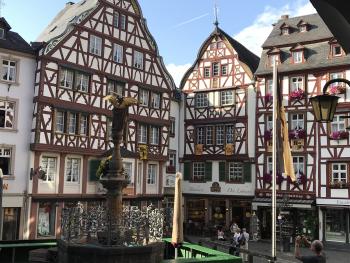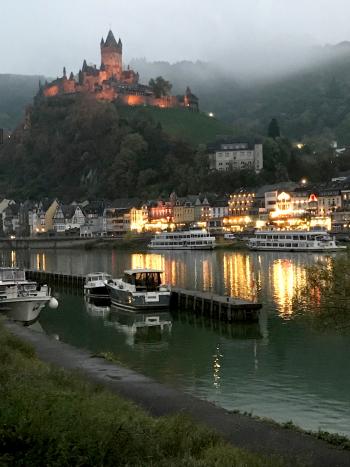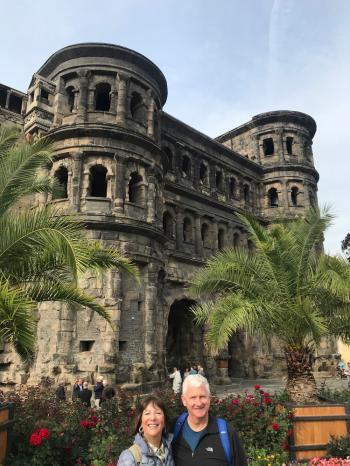Enjoying a bike-and-barge trip along Germany’s Mosel
This article appears on page 30 of the April 2019 issue.
When a former coworker at Northwest Airlines (now part of Delta Air Lines) asked if we wanted to do a bike-and-barge trip on the Saar and Mosel rivers in Germany, my partner, Mike Darling, and I jumped at the chance.
By the time everyone had signed up — a year in advance — there were 29 people in our group. We were very excited to catch up with longtime friends from our airline days and meet the friends of friends who would be joining us.
About the trip
We flew from Portland, Oregon, to Amsterdam on Delta (using my retiree privileges), then continued with KLM to Frankfurt.
We spent the night near Frankfurt's central train station at Hotel Monopol (hotelmonopol-frankfurt.com) for a cost of €108 ($122), including a large buffet breakfast. This location was convenient for catching the train for our 2-hour ride to Saarburg the next morning.
We arrived in Saarburg on Aug. 30, 2018. Our 7-night tour, starting the next day, would have us traveling by bike approximately 25 miles per day to meet the barge every afternoon at a new mooring.
Many of us opted for e-bikes (electric). Though the route was very flat and usually easy to follow, we enjoyed buzzing up the few hills with our extra power. (We caught a lot of flak from those who were on the regular bikes, but I think they were just jealous.)
We booked our tour through Biketours.com (Chattanooga TN; 877/462-2423), who contacted the German tour company that was managing the trip to confirm our reservation. Our ship, the MS Patria, filled up almost immediately upon reservations opening a year in advance!
Besides our group of 29 from the US, there were another six Americans, a large group of Swedes and many Germans on board. (The Patria holds a total of 68 passengers.)
The deposit for the trip was $200 per person plus a $30 booking fee, and the total cost per person was €939 plus €165 for each electric-assist bike, for a total of about $1,389 per person. This was the self-guided version of this trip.
We felt we got good value for the money.
Starting in Saarburg
Saarburg is a small town on the Saar River that is sometimes called "Little Venice." It is a lovely, historic town with waterfalls running through its center. There is also a medieval castle ruin that can be reached via a short walk uphill.
For our first two nights, we stayed at Hotel am Markt (Am Markt 10-16; saarburg-hotel-am-markt.de [in German only]). Our room (€160 for two nights, including breakfast) was in the hotel annex, which was not as charming as the main hotel, but the room was quite spacious.
The hotel was in a great location, with many outdoor cafés right outside the door, and it was walking distance from the train station.
Having some extra time before the bike tour started, a group of us took the train to Trier, about 25 minutes away. We spent the day exploring this city, which was the home of my father and grandparents.
My family had been forced to leave by the Nazis during WWII, and I was determined to find the small brass plaque that was dedicated to my grandfather. These small plaques (Stolperstein) can be found all over the city, in front of the former homes of the victims they commemorate.
Fortunately my cousin had told me where to find the plaque… in front of the Woolworth department store, under one of the clothes racks! (The family home was demolished a long time ago.) This area was just beyond the beautiful main market square.
My grandparents were deported to Gurs internment camp in 1941, but they did make it to the US, unlike so many others.
Trier is a very beautiful city, with many standing monuments from the Roman era, including the Porta Nigra, or Black Gate. I was also impressed by the half-timbered houses, the many huge churches and the Electoral Palace.
We actually went back to Trier for a walking tour on another day after biking. I only wish I had visited Trier while my father was still alive.
Life on and off the barge
Once we boarded the ship, our daily routine went something like this: coffee available in the lounge after 6 a.m., breakfast served at 7:15 (quite an extensive buffet), then up to the cabins to get ready for the day before the briefing (in English) at 8:45.
Our tour director, Dagmar, would explain the highlights of the day and the places we should not miss. She would answer any questions, then we were off on the bikes.
We packed a small lunch to take with us each day, though some chose to eat at some of the many sidewalk cafés along our route.
On return to the barge in that day's port in the afternoon, there would be cakes and coffee/tea.
Of course, the ship's bar was open at all times. Alcohol and soft drinks cost extra, but the drinks were reasonably priced.
On most days, dinner was served at 6:30 and consisted of an appetizer, soup, a main course and dessert. No one went hungry, and the food was always delicious.
After dinner, we could wander around the town or just hang out on board.
Our daily bike rides took us through small villages and many, many vineyards, which were mostly made up of white (green) grapes to make the Riesling that is the specialty of this area.
There were a few times when we did cycle along a busy highway, which was a bit scary, as there were absolutely no barriers whatsoever between the bike path and the highway. Hopefully, no one in Germany is texting and driving!
Along the route were visits to wineries, with tours provided by the ship for an extra charge (usually €13-€15), and stops to see the locks along the Mosel. There were many wine festivals at that time of year, including one in Saarburg on the first night we were in port. There was even a fireworks show, which I watched from our cabin.
Village visits
On Day 4, some of us took a break from cycling in the lovely, small town of Neumagen-Dhron, which claims to be the oldest wine-growing village in Germany. A short way off the bike path was a beautiful replica of an old Roman carving of a wine ship dating from the 3rd century.
A stop in the small village of Pünderich was not to be missed, as the historic Old Town is full of old, half-timbered houses. Lo and behold, when we pulled in, we found some of our group in a café enjoying afternoon libations. There was never a lack of cafés, though they tended to open at 11 a.m. or later in the small towns.
Another highlight in the area was the town of Bernkastel-Kues, which was very crowded with tourists but had a lovely area of half-timbered houses.
On Day 6, everyone stopped at the small village of Beilstein. Called the Sleeping Beauty of the Mosel, the whole village has landmark status.
Some of our group visited the Carmelite monastery there, with St. Josef's Church and its Black Madonna. The view of the Mosel from the Metternich Castle on the hill was spectacular.
Coming to a close
We spent that night in Cochem. After dinner, many of us walked across the bridge to the Old Town. The Imperial Castle on the hill was a truly breathtaking sight.
There were many nice shops in the Old Town, but all were closed at that time of night.
Our tour ended in Koblenz, which is a large city. We didn't have a lot of time to explore there, as we were determined to find a laundromat. Six of us made the short trek, and a nice, young German woman helped us decipher exactly how to work the machines. (The next day we would be going on to Greece, so we needed some clean clothes.)
The crew worked diligently on the morning we departed to ready the barge for the trip in reverse, though we were quite glad we had started in Saarburg.
It was a marvelous trip, with lots of laughter!




